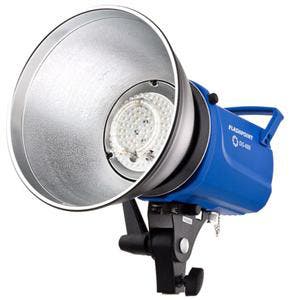The Chicken Delight Company has decided to upgrade its production facility. The new facility has electricity, which is good, because now not only do they have de-chicken, but they have de-light!
A bad joke to be sure, but for the photographer working on location and using AC powered flash units (or even quartz lighting), having de-power is as important as having de-camera! In fact, finding outlets is the first thing my assistant and I do when we walk onto a site we have to photograph in. Without outlets we’re reduced to working by the available, ambient light or with three battery-powered flash units totaling approximately 525 watt-seconds.
On the other hand, give us an outlet (or better yet, four outlets) and we end up with almost 10 times that amount of flash power. And, although working by available light is certainly an option, an accurate color rendition is much easier to achieve with the consistent color temperature light put out by either flash (5600?? K) or quartz (3200?? K) lighting. Further, working with more powerful AC flash units gives me a broad choice of f-stops from which to choose and the ability to use light modifiers such as banks and umbrellas that require more power when compared to direct flash (f-stop output vs. f-stop output).
But….you do need an outlet!
Sometimes, in the huge rooms and factories I work in, the 160 feet of cables (4, 25-foot cords and 4, 15-foot power cords) I regularly carry still aren’t enough to let me put my lights where I want them and still reach an outlet. Sometimes there’s only one outlet available and I want to use two or three lights. What happens then you might ask?
After committing all my cords to my search for power my second line of defense when faced with this situation is called a three-into-one adapter and I carry two of them. These little lifesavers plug into a single outlet and provide you with three outlets instead of the one you’re stuck with. One adapter is plastic (for indoor applications) while the other is rubberized (for outdoor applications) and both cost only a few bucks each. In reality, I prefer the rubberized, outdoor one because the plug sockets are further apart than on the plastic, indoor one.
If the plugs you put in the three outlets are large sized the space between each outlet can make the whole thing workable. Look at photo #1 to see the differences between the two I carry. But I must add a beware here; three 1000 watt-second flash packs and three modeling lamps often draw enough amperage to overload a 20 amp circuit and a circuit breaker popping constantly is almost more frustrating than having no outlet at all!
Of the two 3-into-1 adapters the orange outdoor version is definitely my favorite because of the wider spacing between its outlets but also note that I used a E-Xacto knife to trim away the bump over the middle outlet (note the pencil pointer). By doing this, the bump doesn’t block the second outlet in the wall plate.
Ohm’s Law to the Rescue!
So how can you use two (or maybe even three) flash generators on one 20-amp circuit without popping the circuit breaker because of the overload? Some of today’s flash units offer two different recycle modes; a fast recycle mode that draws a lot of amperage and a slow recycle mode that draws far fewer amps.
While this is a nice, often necessary, feature waiting 5 seconds between photos for your lights to slowly recycle can be a real damper on your creativity. There is also another way to lower your amperage draw that is often worth investigating. A 250 watt modeling lamp draws approximately two amps of power and this means the 3 modeling lights in the three flash heads can eat up 6 of the 20 amps available in the majority of circuits.
If you use flash generator packs that require 6 amps of power , three packs can live harmoniously on one 20-amp circuit without ever popping the breaker, but woe is you if you turn on all three modeling lamps and the flash generators at the same time! Ohm’s law (remember it from high school physics?) states that amperage is the watts (but NOT watt-seconds!) divided by the volts (A=W/V) and it pays to keep that little formula in your mind as you try to wring every amp out of a circuit without popping the breaker.
Using this formula it is easy to see that each 250-watt modeling lamp requires a bit more than 2 amps to operate (250 watts divided by 120 volts equals 2.08 amps). All this means that turning off 3 modeling lamps before you start shooting can save over 6 amps of power usage!
And if, as I do, you often work side by side with video crews you must learn to share the power available and here too it pays to remember the A=W/V equation. A 1000-watt video light eats almost 8.5 amps and, on a 20 amp circuit that leaves only 11.5 amps for your flash unit. In situations like this remembering that you can turn off your 250 watt modeling lamps before you start shooting is the kind of power conservation that can save the day.



